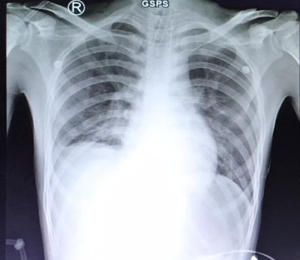Rehabilitation in a Patient with Restrictive Lung Disease Due to Post Partial Right Inferior Lobe Resection with Phrenic Nerve Palsy: Case Report
Authors
##plugins.themes.bootstrap3.article.main##
Abstract
The process of surgical resection is a complex procedure that raises several concerns after experiencing thoracic trauma. Injuries or cardiothoracic surgical interventions have the potential to give rise to phrenic nerve dysfunction, leading to diaphragmatic weakening, a reduction in inspiratory muscle capacity, and decreased lung volume. This impairs respiratory muscle endurance, ultimately manifesting as exertional dyspnea. A 19-year-old male patient with weaning ventilator failure following inferior lobe resection of the right lung and phrenic nerve palsy is the subject of the following case. After achieving stable hemodynamics in the patient, the pulmonary rehabilitation program within the intensive care unit was initiated. Therefore, this program was conducted to improve ventilation, lung volume, and capacity, as well as diaphragmatic excursion. Exercise capacity improved from a six-minute walking test, which covered 135 meters with a VO2 max of 10.04 and 2.87 metabolic equivalent (METs) before discharge. In the outpatient clinic setting, these values improved with the patient able to cover a distance of 294 meters, exhibiting a VO2 max of 13.17, and a METs value of 3.76.
##plugins.themes.bootstrap3.article.details##
Copyright (c) 2024 Ni Luh Made Murniasih Jayanthi, Siti Chandra Widjanantie, Tresia FU Tambunan, Peggy Sunarjo

This work is licensed under a Creative Commons Attribution 4.0 International License.
Creative Commons License All articles published in Annals of Medicine and Medical Sciences are licensed under a Creative Commons Attribution 4.0 International License.
Homo RL, Grigorian A, Lekawa M, Dolich M, Kuza CM, Doben AR, et al. Outcomes after pneumonectomy versus limited lung resection in adults with traumatic lung injury. Updates Surg [Internet]. 2020;72(2):547–53. Available from: https://doi.org/10.1007/s13304-020-00727-4
Caleffi Pereira M, Cardenas LZ, Ferreira JG, Iamonti VC, Santana PV, Apanavicius A, et al. Unilateral diaphragmatic paralysis: inspiratory muscles, breathlessness and exercise capacity. ERJ Open Res [Internet]. 2021;7(1):00357–2019. Available from: http://dx.doi.org/10.1183/23120541.00357-2019
Hegde AM, Pani SC. Drooling of saliva in children with cerebral palsyetiology, prevalence, and relationship to salivary flow rate in an Indian population. Spec care Dent Off Publ Am Assoc Hosp Dent Acad Dent Handicap Am Soc Geriatr Dent. 2009;29(4):163-8.
Stigt JA, Uil SM, Van Riesen SJH, Simons FJNA, Denekamp M, Shahin GM, et al. A randomized controlled trial of post thoracotomy pulmonary rehabilitation in patients with resectable lung cancer. J Thorac Oncol [Internet]. 2013;8(2):214–21. Available from: http://dx.doi.org/10.1097/JTO.0b013e318279d52a
Massery M. Physical Therapy Following Phrenic Nerve Graft Surgery: Implications Far Beyond Breathing. Springer Int Publ Switz. 2017;(October):129–37.
Ahmad A. Essentials of Physiotherapy after Thoracic Surgery: What Physiotherapists Need to Know. A Narrative Review. Clinical Infectious Diseases. Korean J Thorac Cardiovasc SUrg; 2018. p. 293–307.
Verin E, Marie JP, Tardif C, Denis P. Spontaneous recovery of diaphragmatic strength in unilateral diaphragmatic paralysis. Respir Med. 2006;100(11):1944-51.
Keng LT, Liang SK, Tseng CP, Wen YF, Tsou PH, Chang CH, et al. Functional Status After Pulmonary Rehabilitation as a Predictor of Weaning Success and Survival in Patients Requiring Prolonged Mechanical Ventilation. Front Med. 2021;8(June):1–13.

